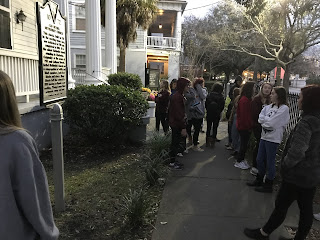 |
| Bethel's small but symbol rich churchyard (photo by Harper Richards) |
The students are in my First Year Experience course "Beyond the Grave: What Old Cemeteries Tell and Teach the Living."
Their assignment was an exercise in gravestone iconology- a scavenger hunt to identify, photograph and interpret at least 10 different examples of marker symbols. They could be different trees, flowers, Christian figures such as crosses and angels, animals such as doves and lambs, and objects such as Bibles and Masonic symbols.
 |
| Camille Wish is the owner of Terrace Oaks Antique Shop |
She took us inside so we could see the lovely sanctuary. Dating to the early 1800s, Bethel has survived hurricanes, earthquakes, floods, wars and termites.
After Hurricane Hugo in 1989, when some repairs were required, some Yankee writing and drawings were discovered in a stairway wall.
 |
| Click on this photo to get a better look at it |
Today, in the stairwell leading to the back balcony, the graffiti can be viewed through a small glass window that protects it.
Wish made some interesting comments about Bethel UMC's place amid Charleston's rich religious heritage, which was brought about, significantly, due to one Lord Ashley Cooper.
Bethel's location, at the corner of Calhoun and Smith streets, "was considered out in the country during the Civil War," she said.
"The churches downtown get more attention," she said. "Bethel gets a little left out. We're a little farther away."
 |
| Photo by Olivia Byrne |
It was a treat for the students (and their teacher!) to be able to explore the beautiful old sanctuary.
A unique feature is how the massive organ is located behind the altar, not up in the balcony as is more common.
Back in the day, before the Civil War- and during I suppose- black congregants had to sit in the balcony, segregated from the white members below.
We also went across Calhoun Street nearby to see what is called "Old Bethel" church. This is the original wooden structure was completed in 1807. It is Charleston's third oldest church.
It was twice moved, first in the 1850s to make way for the church we see today, and then in 1880, when "it was given to the black congregation," according to Old Bethel's website.
Wish said after the Civil War, a Northern white minister rallied black Bethel members to not continue to go along with the segregated service seating.
 |
| Photo by Hailey Brinson |
The Bethel graveyard used to be much larger. But a big part of it today is covered by a parking lot. Dozens of headstones are set against the church walls and a fence.
 |
| Photo by Garrett Wilson |
It was nice to have the extra daylight hours this Monday evening, due to the recent time change.
The outing gets a thumbs up for sure!
Camille Wish, as has previous Bethel members we interacted with, was very welcoming. She invited the students to come attend Sunday service- no matter their religious affiliation.
 |
| Walking along Calhoun Street |
The College of Charleston campus' close proximity to Bethel United Methodist Church makes that a very viable option, indeed.
 |
| This parking lot used to be part of the graveyard |
Many thanks to church historian Camille Wish. She is also a local business person. She owns the Terrace Oaks Antique shop on Maybank Highway in West Ashley.
Stop by and give her some business. Tell her the CofC class sent you!
For more on Bethel- the new one and the old one- see my previous blog post here.




No comments:
Post a Comment